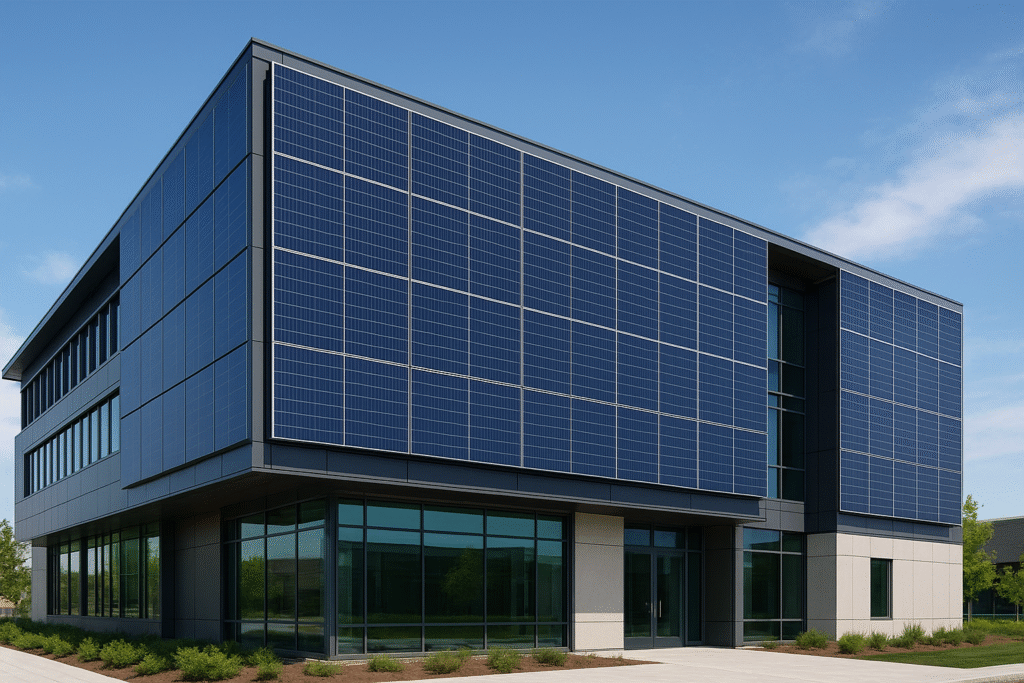Photovoltaic glass is a transparent material designed to capture solar energy and convert it into electricity while functioning as a building element. It integrates solar technology directly into windows, facades, and other glass surfaces, enabling structures to generate power without requiring traditional solar panels. This combination of transparency and energy production makes photovoltaic glass a key innovation in sustainable architecture.
This type of glass typically contains thin layers of solar cells embedded between or coated on glass panes, allowing sunlight to pass through while harvesting energy. Its application ranges from commercial buildings to vehicles, offering a practical method to reduce energy consumption by producing electricity on-site.
By replacing conventional glass with photovoltaic glass, buildings can contribute to power generation while maintaining natural light and aesthetic appeal. This technology represents a growing shift toward sustainable and energy-efficient construction practices.
Understanding Photovoltaic Glass
Photovoltaic glass integrates solar technology directly into building materials, enabling energy generation without disrupting architectural design. It combines light transmission with electricity production through embedded solar cells. The glass type, working principle, and efficiency metrics determine its suitability and performance in various applications.
How Photovoltaic Glass Works
Photovoltaic glass contains solar cells embedded between glass layers or coated on its surface. These cells absorb sunlight and convert it into electrical energy via the photovoltaic effect, where semiconductor materials generate an electric current when exposed to light.
The glass is typically made of low iron glass to maximize light transmission. The solar cells, often silicon-based, are sealed between two glass panes with protective resin or film layers. This design protects the cells while allowing natural light to pass through, enabling windows and facades to generate power without blocking daylight.
Electrical contacts and wiring extract the generated current, which can supply energy to a building or feed into a grid. Some versions include transparent cells that maintain visual clarity while still producing electricity.
Types of Photovoltaic Glass
Photovoltaic glass varies by cell type, transparency, and integration method. The main categories include:
- Opaque PV glass: Contains standard solar cells that fully absorb light, typically used in less visible building areas.
- Semi-transparent PV glass: Allows partial light transmission by using smaller or spaced cells.
- Transparent PV glass: Uses innovative thin-film or organic photovoltaic technologies to generate power while maintaining clear visibility.
Construction varies as well, including laminated glass with solar cells between layers and coated glass with photovoltaic materials applied directly. The choice depends on aesthetic goals, energy needs, and application site, such as rooftops, façades, or skylights.
Efficiency and Performance
Photovoltaic glass efficiency depends on cell material, glass quality, and environmental conditions. Silicon-based cells offer higher efficiency but may reduce transparency. Thin-film and organic cells are less efficient but suitable for transparent applications.
Key performance factors include:
| Factor | Effect |
| Light transmission | Balances visibility and energy |
| Cell type | Determines maximum efficiency |
| Glass thickness | Affects durability and weight |
| Environmental exposure | Impacts longevity and output |
Efficiency typically ranges from 10% to 20%, lower than standalone solar panels but compensated by architectural integration. Proper installation and orientation also play critical roles in maximizing energy output over the building’s lifetime.
Applications and Benefits
Photovoltaic glass enables buildings to generate electricity while maintaining natural light. It is used across various architectural applications, contributing to energy efficiency, cost savings, and environmental goals.
Building-Integrated Photovoltaics
Photovoltaic glass is a key material in building-integrated photovoltaics (BIPV), where solar cells are embedded into structural elements. Windows, facades, and skylights can produce electricity without altering a building’s design. This technology replaces standard glass panels and maintains transparency, allowing daylight inside.
BIPV with photovoltaic glass reduces reliance on external power sources. It integrates energy generation directly into the building envelope, minimizing additional space or mounting infrastructure. This integration supports modern architectural aesthetics and helps buildings achieve energy efficiency certifications.
Commercial and Residential Uses
In commercial buildings, photovoltaic glass can cover large window sections or curtain walls to supply significant energy amounts. This reduces operational costs and improves sustainability ratings.
Residential use includes skylights and window panes installed with transparent solar cells. Homeowners gain electricity generation capabilities while preserving natural views and daylight. The technology suits new builds and renovations, supporting energy independence and utility bill reduction.
Environmental Impact
Photovoltaic glass contributes to lower carbon emissions by producing clean electricity on-site. It reduces dependence on fossil fuels and decreases the carbon footprint of buildings.
Additionally, by combining energy generation with daylighting, it reduces the need for artificial lighting and heating, further cutting energy consumption. The technology supports global efforts to transition to renewable energy without compromising architectural design or indoor comfort.
